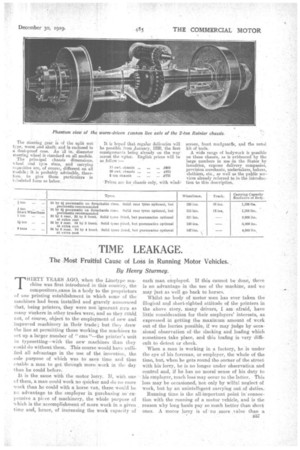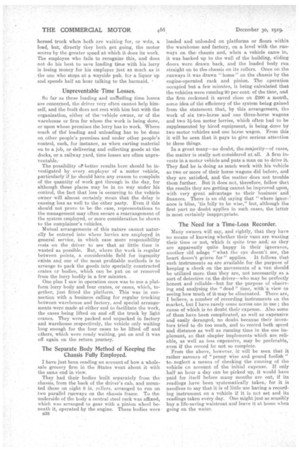TIME LEAKAGE.
Page 15

Page 16

If you've noticed an error in this article please click here to report it so we can fix it.
The Most Fruitful Cause of Loss in Running Motor Vehicles. By Henry Sturmey.
THIRTY YEARS AGO, when the.Linotype machine was first introduced in this country, the compositors:came in a bodyto the proprietors .of one printing establishment in which some of the machines had been installed and gravely announced, that, being printers, they were not ignorant mon as many Workers in other trades were, and so they cr-aild not, of cOurse, object to the employinent of new and improved machinery in Their trade; but they drew the line at permitting those working the machines to set up a larger number of "ems "—the printer's unit in typesetting—with the new machines than they could do without them. This course would have nullified all advantage in the use -of the invention, the sole purpose of which was to save time and thus enable a man to get through more work in the day than he could before.
It is the same with the motor lorry. If, with one of them, a man could work no quicker and do no more -work than he could with a.horse van, there Would be no advantage, to the employer in purchasing so-expensive a piece of machinery, the whole purpose of which is the .accomplishment of more work in a given , time and, hence, of increasing the work capacity of each nian employed. If this cannot be done, there is no advantage in the use of the machine, and we may just as well go back to horses.
Whilst no body of motor men has ever taken the illogical ansl short-sighted attitude of the printers in the above story, many drivers, I am afraid, have little consideration for their employers' interests, as expressed in getting the maximum amount of work out of the lorries possible, if we may judge by occasional observation of. the slacking and loafing which sometimes take place, and this krafing is very difficult to detect or check.
When a man is working in a factory, he is under the eye of his foreman, or employer, the whole of the time, but, when he gets round the corner orthe street with his lorry, he is no longer under observation and control and, if he has no 'moral-sense of his duty to his employer, much loss may occur to the latter. This loss may be occasioned, hot only by wilful neglect of work, but by an unintelligent carrying out of duties.
Running time is the all-important point in' comiection with the running of a motor vehicle, and is the reason why long hauls pay so much better than short ones. A motor lorry is of no more :value than a horsed truck when both are waiting for, or with, a load, but, directly they both get going, the motor scores by the greater speed at which it does its work. The employee who fails to recognize this, and does not do his best to save loading time with his lorry is losing money for his employer just as much as is the one who stops at a wayside pub. for a liquor up arid spends half an hour talking to the barmaid.
Unpreventable Time Losses.
So far as these loading and unnfading time losses are concerned, the driver very often cannot help himself, and the fault does not rest with him but with the organization, either of the 'vehicle owner, or of the warehouse or firm for whom the work is being done, or upon whose premises the lorry has to work. Where much of the loading and unloading has to be done on, other people's premises and under other people's control, such, for instance, as when carting material on to a job, or delivering and collecting goods at the docks, or a railway yard, time losses are often unpreventable: The possibility oPbetter results here should be investigated by every. en-.iployer of a motor vehicle, particularly if he should have any reason to complain of the quantity of work got through in the day, for although these places may be in no way under his control, the fact that loss is occurring to the vehicle owner • will almost certainly mean that the delay is causing loss as well to the other party. Even if this should not prove to be the. case, representations to the management may often secure a rearrangement of the system employed, or more consideration be shown to the complainer's vehicles.
, Mutual arrangements of this nature cannot naturally be entered into where lorries are employed in general service, in which case more responsibility rests on the driver to see that as little time is wasted as possible. But, where the -work is regular between points, a considerable field for ingenuity exists and one of the most profitable methods is to arrange to pack the goods into specially constructed crates or bodies, which can be put on or removed from the lorry bodily in a few minutes.
One plan I saw in operation once was to use a platform lorry body and four crates, or eases, which, together, just fitted the platform. This was in connection with a business calling for regular trucking between warehouse and factory, and special arrangements were made at either end to facilitate the work, the cases being lifted on and off the truck by light cranes. They were packed and unpacked in factory and warehouse respectively, the vehicle only waiting long enough for the four cages to be lifted off and ethers, which were ready waiting, put on and it was off again on the return 3ourney.
The Separate Body Method of Keeping the Chassis Fully Employed.
I have just been reading an account of how a whole. sale grocery firm in the States went about it with the same end in view.
They had their bodies built separately from the chassis, from the back of the driver's cab, and mounted these on eight 6 in. rollers, arranged to run on two parallel runways on the chassis frame. To the underside of the body a central steel rack was affixed, which was arranged to gear with a pinion wheel beneath it, operated by the engine. These bodies were B28 loaded and unloaded on platforms or floorswithin. the warehouse and factory, on a level with the runways on the. chassis and, when a vehicle came in it was backed up to the wall of the building, sliding doors were drawn back, and the loaded body rim straight on to the chassis on its rollers. Once onthe runways it was drawn "home" on the chassis by the engine-operated rack and pinion. The nperation occupied but a few minutes, it being calculated that the vehicles were running 90 per cent, of the time, and the firm reckoned it saved close on £200 a month, some idea. of the efficiency of the system being gained from the statement that, by this arrangement, the work of six two-horse and one three-horse wagons and two 3i-ton motor lorries, which often had to be supplemented by hired equipment, is being done by two motor vehicles and one horse wagon. From this it will be seen that it pays to give serious attention to these things.
In a great many—no doubt, the-majority—of cases, the matter is really not considered at all. A firm invests in a motor vehicle and puts a man on to drive it. They find he is doing as much work with his vehicle as two or more of their horse wagons did before, and they are satisfied, and the matter does not trouble them further. But it does not, therefore, follow that the results they are getting cannot be improved upon, with very great advantage to their business and finances. There is an old saying that "where ignoranee is bliss, 'tis folly to be wise," but, although he• first part no doubt applies in such eases, the latter is most certainly inappropriate.
The Need for a Time-Loss Recorder.
Many owners will say, and rightly, that they have no means of knowing whether their vans are wasting their time or not, which is quite true and, as they are apparently quite happy in their ignorance, another old adage " what the eye doesn't see, the heart doesn't grieve for", applies. It follows that such instruments as are available for the purpose of keeping a cheek on the movements of a van should be utilized more than they are, not necessarily, as a sort of detective cn the driver—who may be perfectly honest and reliable—but for the purpose of observing and analysing the " dead " time, with 'a view to seeing how much of it may be eliminated. There are, I believe, a number of recording instruments en the market, but I have rarely come across one in use ; the cause of which is no doubt their expense. Also some of them have been complicated, as well as expensive and easily deranged, no doubt because their inventors tried to do too much, and to rece-rd both speed and distance as well as running time in the one implement, so that simpler implements which are reliable, as well as less expensive, may be preferable, even if the record be not so complete.
From the above, however, it. will be seen that it rather savours of "penny wise and pound foolish" to. neglect a means of checking the running of the vehicle on account of the initial expense. If only half an hour a day can be picked up, it would have paid for itself before many months are out, if its readings havefl been ,systematically taken,for it is needless to say that it is of little use having a recording instrument on a vehicle if it is not set and its readings taken every day. One might just as sensibly buy a life-saving waistcoat and leave it at home when going on the water.


























